Four broad categories of functions can be IoT utilities:
- Operating things
- Knowing the status of things
- Detecting the movement of things
- Communicating between things
IoT utilities
Four functions of IoT
- Operate things (ex., turn on the air conditioner at home from outside)
- Know the status of things (ex., Check the remaining battery level of electronic devices from a remote location)
- Detect the movement of things (ex., Understand the real-time operation status of buses)
- Communicate between things (ex., brighten the lights when someone enters the room)
They all have remote monitoring, operating, and controlling things in common. In some cases, more than one function is used simultaneously.
Detailed explanations of each function follow.
IoT function Manipulates things

As an example of IoT, it may be possible to remotely control things in a remote location, for instance, by using a smartphone.
With a smartphone or another device, you can control home appliances such as air conditioners and lights or open and close doors and shutters outside the house using your smartphone or other device. Additionally, IoT-enabled pet food servers can be monitored remotely via your smartphone at any time so that you can automatically feed your pet the appropriate amount of food based on their condition.
It is important to note that you cannot only control simple functions like turning the air conditioner on and off but also fine-tune specific settings, such as the temperature of the air conditioner and the strength of the air circulation. There are many ways to make life more convenient by manipulating things to make life easier.
IoT functions, knowing the status of things

When discussing the Internet of Things, knowing the status of things and people in remote locations is also essential.
For example, with phone apps like this, you can check the status of your lights on the go so you will remember to turn them off, reducing your electrical bill and preventing you from forgetting to do so. As an additional benefit, you can also monitor the health status of your pet remotely by controlling the temperature of the air conditioner from a remote location to maintain an optimal temperature in the indoor environment and by using IoT collars to collect information regarding the amount of exercise and food your pet consumes. You will be able to react quickly and consult a veterinarian as soon as possible, helping prevent significant health problems.
The critical point here is that acquiring information from sensors installed in objects and sending and receiving data via the Internet makes it possible to gain awareness about the conditions of objects and people. It is common for people to use the “knowing the status of things” function to obtain important information that can lead to real-time action.
In addition, this innovation makes a lot of significant worth in the business field, as it straightforwardly gets data, for example, utilization recurrence and use time from the clients. This technique can decide the client’s necessities without leading showcasing examination or reviews, so the information can be utilized to improve and foster the item.
IoT function detecting the movement of things

The IoT can also provide information about the current situation through the movements of things and people.
As a result of combining sensing technology that detects the movement of people and things with the Internet of Things, autonomous driving technology will be dramatically improved, and accidents on construction sites will be reduced.
IoT can detect movements that impact the cultivation environment, such as temperature, humidity, and water level, and adjust the environment automatically to achieve the optimal situation in agriculture. Buses and trains can be monitored for operation status and public transportation congestion. Real-time tracking of passengers at the bus stop is possible.
Since it is possible to monitor the environment around objects, trends in measurement values, people’s movements and lifestyles, etc. Abnormalities can be detected and responded to appropriately and promptly in real-time. To take quick action without missing essential changes in the activity of things or people, you need to be able to predict the current situation and react quickly.
IoT function Communicates between things
The fourth feature allows you to operate multiple electronic devices by automatically sending and receiving data between connected devices.
Smart homes and intelligent buildings are typical examples of this function, which combines the three introduced so far. A smart speaker with AI lets you operate your home with voice commands, such as turning on the air conditioner, turning on the lights, or opening and closing curtains. As well as saving energy, it will control office entry and exit to eliminate wasteful energy consumption.
The ability of self-driving cars to communicate with one another is attracting particular interest. There are efforts underway to reduce traffic congestion by allowing cars to automatically reduce speed based on traffic light data, as well as by detecting road congestion at traffic lights in real-time and adjusting waiting times accordingly. In the process of being implemented
With the commercialization of 5G, the next-generation communication technology, which will be used by 2020, technology that connects multiple functions like this is evolving rapidly.
It is a technology with high expectations, particularly in the field of “automation,” because things communicate with one another, make decisions, and operate without human guidance.
Utilization of IoT data

Data can also be collected from each object using the four functions of IOT. They can also be saved and accumulated over the Internet. A correlation and trend analysis can also be performed on the collected data (big data) to obtain hints for improvements or development of new services.
Example of data utilization
Operate things
Example: Turn on the air conditioner at home from outside.
It is essential to understand the characteristics of the time of day when the air conditioner is most commonly turned on and make a reservation to turn it on at that time.
Know the status of things
Example: Understand the remaining battery level of electronic devices from a remote location.
Analyze how much battery power will remain in the battery by measuring how much battery power will decrease over time and order batteries automatically as necessary.
Detect the movement of things
Example: Understand the real-time operation status of buses.
The objective is to understand the current status of service delays and propose changes to the routes or an increase in the number of buses based on analyzing the city’s crowded areas and time zones.
Communicate between things
Example: Brighten the lights when someone enters the room.
To minimize power consumption, it is essential to understand the entry status and store power during periods when fewer people are entering and leaving.



